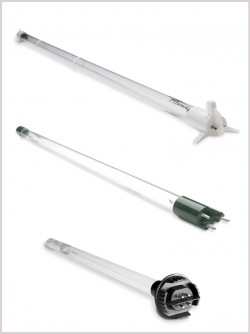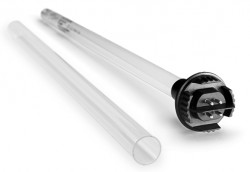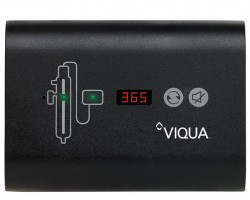
Components of a UV System
An ultraviolet disinfection system (UV system) is more than the sum of its parts. It’s a chemical-free, highly effective (to 99.9%) method to remove the threat of microbiological contaminants from water.
Each of the components of a UV system plays an important role, and by understanding them and how they work together we hope to make the process a bit less mysterious.
Main Components of a UV system
There are a variety of UV disinfection systems on the market, however, they all contain the same general components, from the very large systems that disinfect water for commercial or industrial operations, right down to an under-sink system treating drinking water at the point of use.
The four main components of a UV system are:
- The reactor chamber
- The UV lamp
- The quartz sleeve
- The controller unit (also called a ballast)
There are other optional parts such as sensors and solenoid valves that can also be a part of a system, however, these four components are the basis of all UV systems.
The Reactor Chamber
The reactor chamber, also known as just a chamber or a reactor, is the part of the system that physically houses the UV lamp and sleeve, as well as controlling the flow of water through the system.
They are usually constructed of stainless steel, but some manufacturers use different materials. There are different types of reactors available, such as axial or boot shape, and reactors come with ports in a variety of sizes depending on the model and the flow rate the system is intended to service.
Different types of welds, end caps, and other design features can give a different look visually. Essentially, all chambers perform the same function, no matter how they look aesthetically.
The UV Lamp
 To the layperson, all UV lamps look the same. Essentially, they all perform the same function. They produce UV-C, which isthe wavelength of UV light that is considered germicidal. However, different lamps perform this function in various ways, depending on the application and disinfection requirements.
To the layperson, all UV lamps look the same. Essentially, they all perform the same function. They produce UV-C, which isthe wavelength of UV light that is considered germicidal. However, different lamps perform this function in various ways, depending on the application and disinfection requirements.
All UV lamps, regardless of output, contain mercury. You may think, “Isn’t that stuff dangerous for the environment?” Mercury in high levels is definitely dangerous. But UV lamps generally contain a bead of mercury about the size of the head of a pin, and all lamps can be recycled, much like the fluorescent light bulbs that you can purchase at the local retail store.
During operation of the lamp, the mercury is completely contained within the lamp structure, and with proper recycling, these lamps are harmless and provide no risk to the environment. Mercury is a vital part of the lamp’s ability to produce the germicidal UV-C light wavelength. Minute liquid mercury droplets collect at the lamp’s “cold spot”, and once they reach peak temperature, UV-C light is emitted.
All UV lamps have filaments just like a regular light bulb to produce an electrical current that heats up the mercury and evaporates it into the air inside the lamp. This evaporated mercury helps create electrical arcs that produce UV-C at varying intensity levels to disinfect water.
There are three main types of UV lamps that will be found in most UV systems available to the residential and light commercial markets.
- Low-pressure standard UV lamps – These lamps are most often used in applications where the flow rates are lower (such as in a residential home), and exposure times can be longer. These lamps are lower cost to replace, and generally the initial equipment cost is much lower as well.
- Low-pressure high output (HO) lamps – HO lamps are used in applications where higher dosages or flow rates are required, but still have a smaller footprint. They treat water with a broader tolerance to temperature (temperature can affect lamp performance). These lamps are often used in larger flow applications or light commercial systems.
- Low-pressure amalgam lamps – These lamps use mercury amalgam mix to control vapor pressure. They use a slightly different process to yield up to three times the UV-C output of a standard low-pressure lamp of the same length. Predominantly, these lamps are used in more commercial-type applications or for regulations requirements, depending on the type of microbiological contamination being treated.
There are also medium-pressure UV lamps, however these are exclusively used for larger-scale operations, and have essentially no application in the residential market. They are the types of lamps that are used in drinking water and wastewater treatment plants.
Different lamps from various manufacturers will use different types of glass in the lamp structure. You will either find soft glass, or harder quartz glass. Soft glass can be slightly less costly, however due to harder nature of quartz glass, it’s much less likely to break. Soft glass can also cloud with time, and this transmits less germicidal UV-C through to the water, rendering it less effective as it ages. Quartz glass transmits UV more effectively and is less likely to cloud. Both types of glass are often coated to help increase their UV-C transmission.
The Quartz Sleeve
The quartz sleeve is a long, cylindrical tube of quartz glass intended to protect the UV lamp which is powered by electricity from the flow of water. The lamp is inserted into the tube, and transmits the light through the tube into the water. Sleeves can foul with minerals and other contaminants over time, and should be cleaned whenever the lamp is changed. It’s a relatively simple component, but it’s very necessary to the efficient operation of a UV system.
The Controller Unit
The controller unit is the brains of the entire UV system. This is the part of the unit that controls the electrical output of the lamp, and powers it to produce UV-C light. Some controllers are very simple, and are a simple cap that fits over the end of the lamp and a plug. Other controllers, depending on the type of UV system, are more complicated, and have lamp-change timers, low-UV alarms, or trouble indicator lights to show when the system is not performing as it should. These units vary in complexity and size, but essentially, they all do the same thing.
 Each UV system manufacturer has its own “bells and whistles” when it comes to their system performance. All UV systems are engineered for all the parts to work together as a complete functional system. If you have a UV system and it’s time to change your lamp, be sure to use a branded replacement lamp from the system’s manufacturer. Using cheaper, non-manufacturer replacement lamps can end up causing more issues than the amount of money they might save you, and for most manufacturers, will void your product warranty. These non-manufacturer lamps were not engineered specifically to be a part of the complete system, and can compromise the performance of your UV unit.
Each UV system manufacturer has its own “bells and whistles” when it comes to their system performance. All UV systems are engineered for all the parts to work together as a complete functional system. If you have a UV system and it’s time to change your lamp, be sure to use a branded replacement lamp from the system’s manufacturer. Using cheaper, non-manufacturer replacement lamps can end up causing more issues than the amount of money they might save you, and for most manufacturers, will void your product warranty. These non-manufacturer lamps were not engineered specifically to be a part of the complete system, and can compromise the performance of your UV unit.
If you aren’t getting the highest degree of disinfection performance, you aren’t getting the most out of your UV system, and your water is not being properly protected. If you aren’t sure if you are using the right lamp, don’t be afraid to call the manufacturer. They are always happy to help you to ensure your system is working at peak capacity by using the correct lamp for the system.